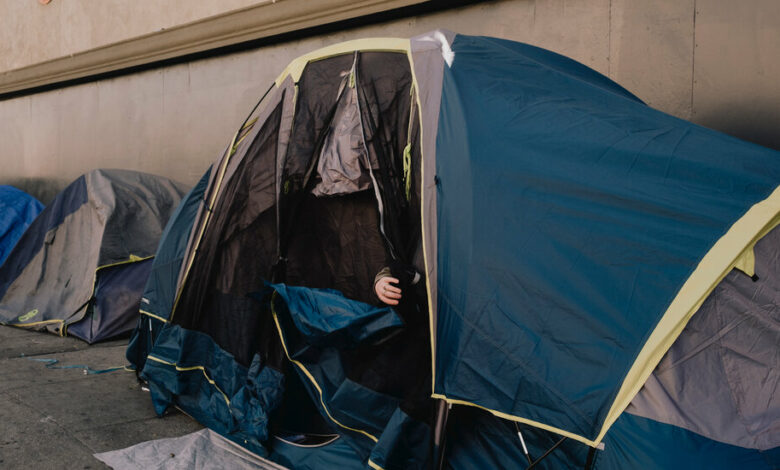Los Angeles homeless population falls for first time in seven years

Longtime homeless Los Angeles residents were optimistic when Mayor Karen Bass began an aggressive effort to move people from encampments into motel rooms in late 2022, shortly after she took office. Piles of items were removed from highway underpasses. Sidewalks blocked by rows of tents were cleared.
But even as Ms. Bass touted the success of Inside Safe, her signature program aimed at getting people off the streets, she warned that the population of homeless Angelenos could still grow before her efforts make a dent.
Ms. Bass and her allies received important confirmation Friday: For the first time in seven years, the number of homeless people in Los Angeles fell from the year before, according to the region’s most recent count, which took place in January.
In Los Angeles, the nation’s second-largest city, where camps have been a nuisance to neighbors for years, the total number of homeless people fell by 2.2 percent, while the number of homeless people in the city (homeless people who are not in a emergency shelter and sleeping on the street, in tents or in cars) fell by 10.4 percent.
Homelessness has become a top concern of voters on the West Coast, where cities are struggling to figure out how to move people indoors and into permanent housing. California has a severe housing shortage, and more encampments have sprung up during the pandemic, including in suburban areas where they previously did not exist.
Hours before the Los Angeles data were released on Friday, the Supreme Court issued a ruling that will make it easier for local governments on the West Coast to ban sleeping in public. But Ms. Bass said the ruling made little difference for Los Angeles, because the city could move forward without arresting homeless people.
“The only way to address this crisis is to bring people home with housing and support services,” she said in a statement. “We will continue to lead the way with this approach in the city of Los Angeles. We cannot go backwards; we must continue to innovate and move with intention and urgency.”
The count results from a point in January indicate that Los Angeles leaders have had success in moving encampment residents indoors but have made less progress in finding permanent homes for them, experts said. That finding was reinforced by a rise in the number of homeless people living in shelters or temporary housing, including motels.
“It’s showing some signs of progress, or at least a bending of the curve,” said Dr. Margot Kushel, director of the Benioff Homelessness and Housing Initiative at the University of California, San Francisco. “We’re starting to do the right things, but we’re not doing them at scale.”
It’s certainly better for people experiencing homelessness to stay in shelters than on the streets, she said, both for the homeless and for the neighborhoods where they camp. New York and California have a similar share of homeless people. But in New York City, almost all homeless residents stay indoors because the city is required by law to provide shelter for the homeless.
The federal government requires local officials to conduct regular homeless counts in various regions of the country. In Los Angeles, this is done annually.
Every year, dozens of volunteers fan out across Los Angeles County and count the number of people they see who appear to be homeless. Professional counselors then gather demographic data by asking homeless people more specific questions, such as how long they’ve been living on the streets and how they became homeless.
The counts are meant to be snapshots of a region’s homeless population. And because so many factors can affect the results — weather, volunteer errors, subtle shifts in data analysis — the counts are imperfect.
The counts attempt to capture not only the number of people living in shelters or on the streets, but also the number of people sleeping in cars. Anyone living in a tent or sleeping in a car is considered unsheltered.
The results this year were mixed in California: Sacramento’s Biennial Census found a sharp decline in the local homeless population in general. San Francisco Leaders Emphasize a significant decrease in street homelessness, but the city’s overall homeless population increased. In Orange County, where housing is expensive and emergency shelter beds are few, the region the biennial count showed a large increase in unsheltered and total homelessness.
The counts are one of the few tangible ways to measure progress for now. And for many leaders in Los Angeles, this year’s results are crucial evidence that it is possible to turn things around after spending millions of dollars to address homelessness for years, only to see the numbers rise, in some recent years by more than 10 percentage points.
From the research of Dr. Kushel has found that the biggest causes of homelessness are economic, specifically a lack of access to affordable housing. Los Angeles has an acute housing shortage, which most likely means people will remain homeless and put pressure on the already tight supply of temporary housing. And moving people into permanent housing remains an even greater challenge.
According to Dr. Kushel, momentum in Los Angeles is further at risk as funding to address homelessness dries up amid the pandemic and the state and city face budget shortfalls.
“If the underlying economic conditions don’t change and if the money is cut, you will see an increase again,” she said. “The hope is that we will see signs of progress and that they will continue to make those absolutely essential investments.”
Nithya Raman, a Los Angeles City Council member who was elected in 2020 on promises to reduce homelessness, said Inside Safe was one of many initiatives that were starting to make a difference. In recent years, the city has added thousands of shelter beds and plans to create hundreds more this year.
Ms. Raman pointed to tenant protections that helped avert a feared wave of evictions after tenants lost their pandemic relief. City officials have also tried to build more affordable housing.
“These are all paying off now,” she said.




